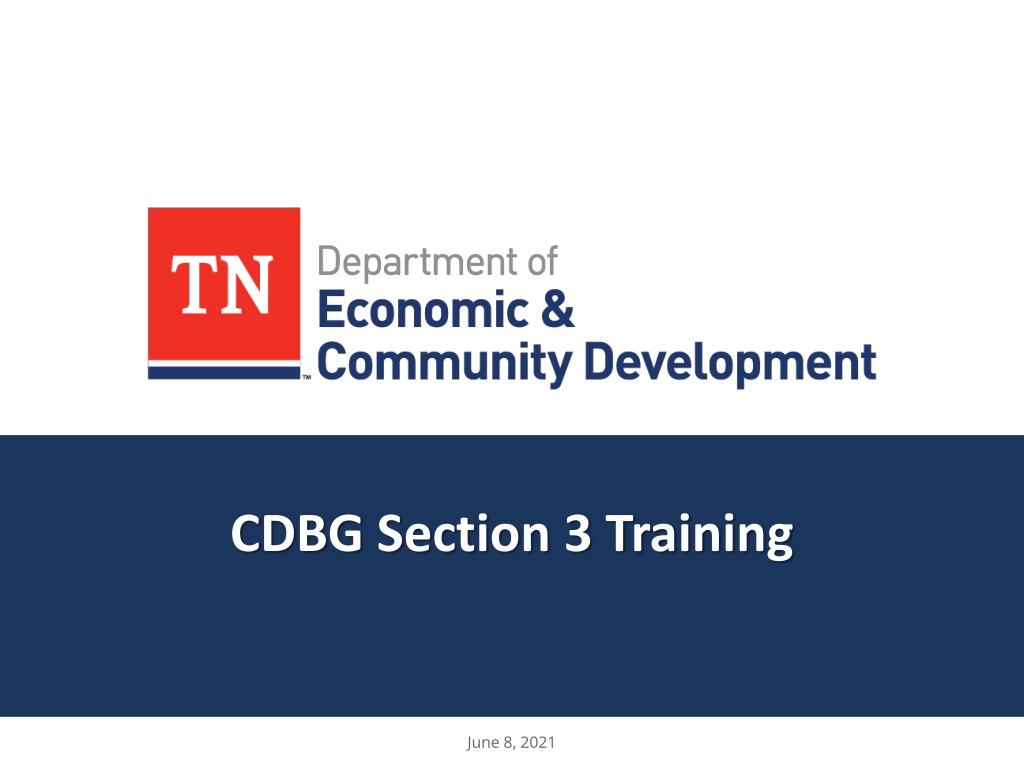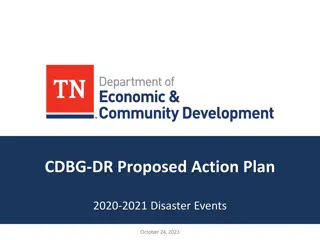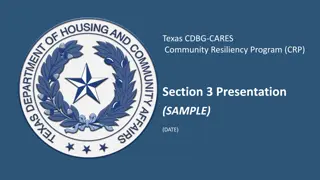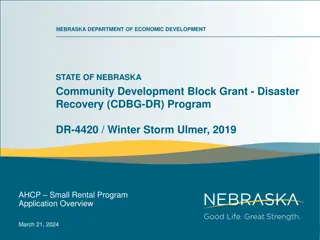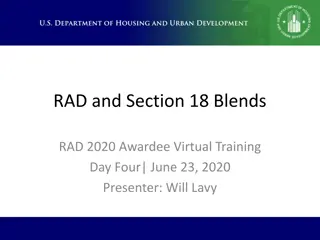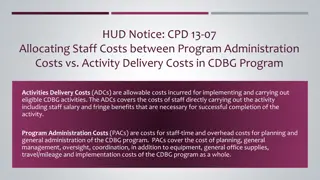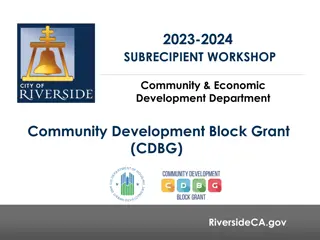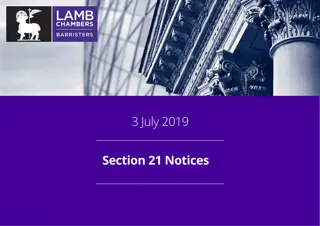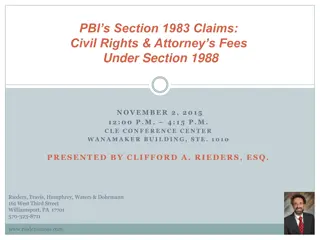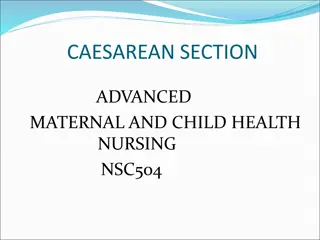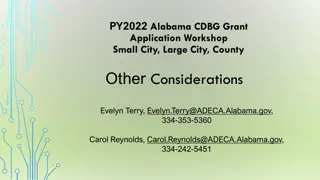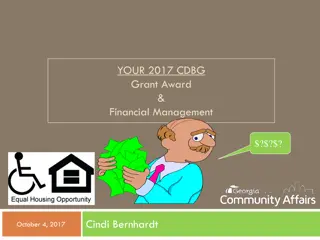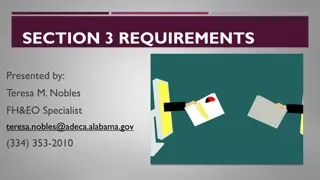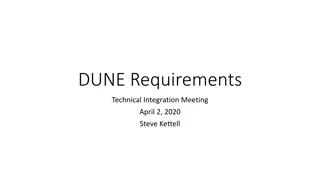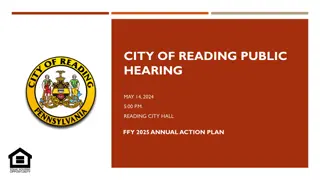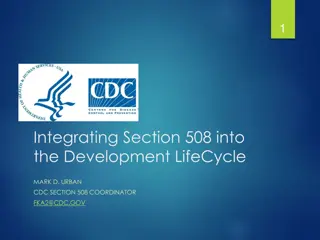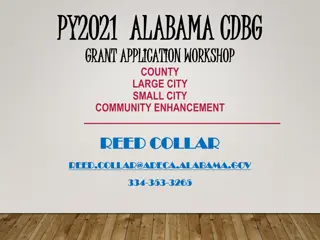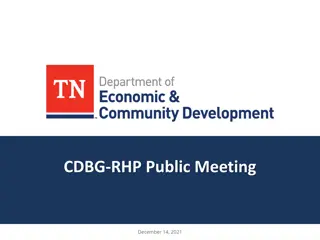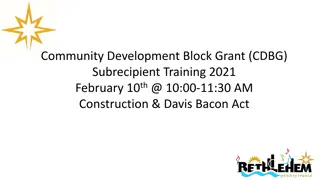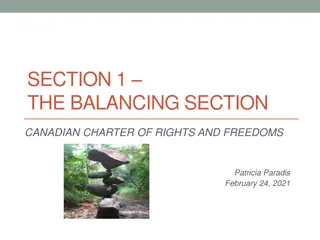CDBG Section 3 Requirements
CDBG Section 3 training covers the provisions of the Housing and Urban Development Act of 1968 aimed at providing economic opportunities to low-income individuals in communities receiving HUD financial assistance. Learn about the applicability criteria, project-based requirements, exemptions, and employment and training priorities for Section 3 workers and businesses.
Download Presentation

Please find below an Image/Link to download the presentation.
The content on the website is provided AS IS for your information and personal use only. It may not be sold, licensed, or shared on other websites without obtaining consent from the author.If you encounter any issues during the download, it is possible that the publisher has removed the file from their server.
You are allowed to download the files provided on this website for personal or commercial use, subject to the condition that they are used lawfully. All files are the property of their respective owners.
The content on the website is provided AS IS for your information and personal use only. It may not be sold, licensed, or shared on other websites without obtaining consent from the author.
E N D
Presentation Transcript
CDBG Section 3 Training June 8, 2021
Section 3 Overview Section 3 of the Housing and Urban Development Act of 1968 Enacted to bring economic opportunities generated by certain HUD financial assistance expenditures, to the greatest extent feasible, to low- and very low-income persons residing in communities where the financial assistance is expended Applies to HUD public housing programs and housing and community development assistance, including CDBG. 24 CFR Part 75
Section 3 Applicability Applicability is determined by meeting the requirements of three criteria: 1. The project is funded in whole or in part by HUD Community Planning and Development (CPD) funding, includes CDBG. 2. Funding is used for one of the following types of projects: Housing rehabilitation (including reduction and abatement of lead-based paint hazards, but excluding routine maintenance, repair and replacement) Housing construction Other public construction 3. The total amount of assistance cost of the project exceeds $200,000.
Section 3 Applicability Section 3 requirements are project-based and are not cumulative for a grantee or subrecipient if it receives multiple HUD-funded grants for multiple projects. Example: A local government receives CDBG funds and undertakes two projects: 1) Water system improvements with $500,000 of CDBG funding and 2) Commercial fa ade improvements with $100,000 of CDBG funding. These two separate projects are unrelated. Because the commercial fa ade improvements have a total amount of assistance less than $200,000, Section 3 would not apply to this project, but Section 3 would still apply to the water system improvements project.
Section 3 Does Not Apply Section 3 does not apply to the following types of projects: Contracts for materials Contracts for professional services, as defined in this document Engineering Architecture Grant Administration Other non-construction services that require an advanced degree or professional licensing Procurement of equipment not related to housing rehabilitation, housing construction, or other public facilities construction, including fire trucks, ambulances, etc.
Employment and Training Requirements Where feasible, priority for opportunities and training should be given to: Section 3 workers residing within the service area or the neighborhood of the project, and Participants in YouthBuild programs. Where feasible, priority for contracting opportunities: Section 3 business concerns that provide economic opportunities to Section 3 workers residing within the service area or the neighborhood of the project, and YouthBuild programs.
Section 3 Worker The new Section 3 rule defines two subsets of workers for Section 3 projects: Section 3 Worker Targeted Section 3 Worker A Section 3 Worker is any worker who currently fits, or when hired within the past five years fit, at least one of the following categories, as documented: The worker is employed by a Section 3 business; The income limit established by HUD (the worker is either low- or very-low income); The worker is a YouthBuild participant.
Targeted Section 3 Worker A Targeted Section 3 Worker is any worker who currently fits, or when hired within the past five years fit, at least one of the following categories, as documented: The worker is employed by a Section 3 business; or Low- or very low-income workers residing within a one- mile radius of the Section 3 project. If fewer than 5,000 people live within that one-mile radius, the circle may be expanded outward until that population is reached or the neighborhood of the project, as defined; or The worker is a YouthBuild participant.
Section 3 and Target Section 3 Workers Note that all Targeted Section 3 Workers also meet the definition of Section 3 Workers.
Determining Section 3 Worker Status The status workers on Section 3 projects can be determined using the following methods. 1. Worker income self-certification the use of certification forms provided to contractors and subcontractors working on the project. Each worker on the project must complete the provided certification form to be kept in the grant record for reference when tracking and aggregating labor hours worked. Section 3 Worker Certification (Exhibit L-1) Targeted Section 3 Worker Certification (Exhibit L-2) 2. Worker is employed by a Section 3 Business Concern The contractor or subcontractor is able to provide documentation that it qualifies as a Section 3 Business Concern. All employees of a qualifying business will be considered Section 3 workers.
Determining Section 3 Worker Status 3. Worker is a Youthbuild participant Verifiable documentation must be provided by the worker or the employer showing the worker is participating in a Youthbuild program. 4. Employer wage records The employer is able to provide certified documentation that the worker's income from that employer is below the income limit for the corresponding family size when based on an employer's calculation of what the worker's wage rate would translate to if annualized on a full-time basis. * Documentation submitted by employers should only contain employee names, state and county of residence, annual income, and a certifying signature and date. Do not include any information such as social security numbers or bank account information.
Section 3 Business Concern The definition of a Section 3 Business Concern has been changed that a qualifying business must meet one of the following criteria, documented within the past 6 months: The business is at least 51 percent owned and controlled by low- or very low-income persons At least 75 percent of the labor hours performed for the business over the prior three-month period are performed by Section 3 workers The business is at least 51 percent owned and controlled by current public housing residents or residents who currently live in Section 8- assisted housing The Section 3 Business Self-Certification (Exhibit L-3), and necessary backup documentation must be submitted by the qualifying business.
Subrecipient/Grantee Responsibilities Establish and maintain a list of resources and organizations that offer training and employment opportunities in the area. Temp services Jobs centers Youthbuild programs Etc. Make TNECD aware of Section 3 Businesses in your area. Make contractors and subs aware of Section 3 at the pre- construction conference.
Subrecipient/Grantee Responsibilities Monitor contractors and subcontractors for Section 3 compliance. Make best efforts to meet Section 3 and Targeted Section 3 Worker benchmarks. Report on efforts if benchmarks are not met. Establishing the geography of the Targeted Section 3 Worker area if fewer then 5,000 people live within a 1-mile radius of the project area. (Usually this will be the community.)
Contractor Responsibilities Ensure subcontractors are aware of Section 3 requirements and responsibilities. Maintain and provide a list of permanent employees working on the Section 3 project who were hired within the last 5 years and their Section 3 status. This will be completed as part of the Project Wage Rate and Section 3 Classification form (Exhibit I-1) . Make a best effort to hire Section 3 or Targeted Section 3 Workers when new hires are necessary.
Section 3 Benchmarks Section 3 Workers = 25% of total labor hours Targeted Section 3 Workers = 5% of total labor hours Any labor hours counted toward the total for Targeted Section 3 Workers will also count toward the total for Section 3 Workers.
Reporting Subrecipients are required to report the following at project closeout: The total number of labor hours worked The total number of labor hours worked by Section 3 workers The total number of labor hours worked by Targeted Section 3 workers The percentage of labor hours worked by Section 3 workers The percentage of labor hours worked by Targeted Section 3 workers If benchmarks are unmet, qualitative efforts and explanation of those efforts
Reporting Labor hours can be verified using weekly payrolls and the Project Wage Rate and Section 3 Classification form (Exhibit I-1). The Section 3 Labor Hours Tracking Form (Exhibit L-5) has been provided simplify tracking of labor hours a best we can. A complete and accurate I-1 form for each contractor and subcontractor is essential.
TNECD Monitoring When TNECD monitors a project, the following will be reviewed. Project Wage Rate and Section 3 Classification forms (Exhibit I-1) Sampling of Section 3 Worker Certifications (Exhibit L-1) Sampling of Targeted Section 3 Worker Certifications (Exhibit L-2) Section 3 Business Self-Certification forms (Exhibit L-3) and backup documentation (if applicable) Section 3 Labor Hours Tracking Form (Exhibit L-5) and a sampling of weekly payrolls List of resources and organizations that offer training and employment opportunities in the area Additional efforts
Which Grants are Affected? The new Section 3 reporting begins July 1, 2021. Grants that are completed prior to July 1, 2021 are exempt. Construction and housing rehabilitation contracts issued prior to November 30, 2020 are exempt. All other project are subject to the new requirements.
Important Highlights Transition to labor hours, not new hires $200,000 project threshold Construction and housing rehab only Section 3 benchmarks Section 3 Workers = 25% of total labor hours Targeted Section 3 Workers = 5% of total labor hours July 1, 2021 effective date 24 CFR Part 75
Questions and Comments Any questions or comments? TNECD will work with you through this transition. This is a lot for all of us. CDBG Manual Chapter L: Section 3 https://www.tn.gov/ecd/community-development-block- grant/cdbg/cdbg-manual.html
Kent Archer (615) 354-3591 kent.archer@tn.gov
